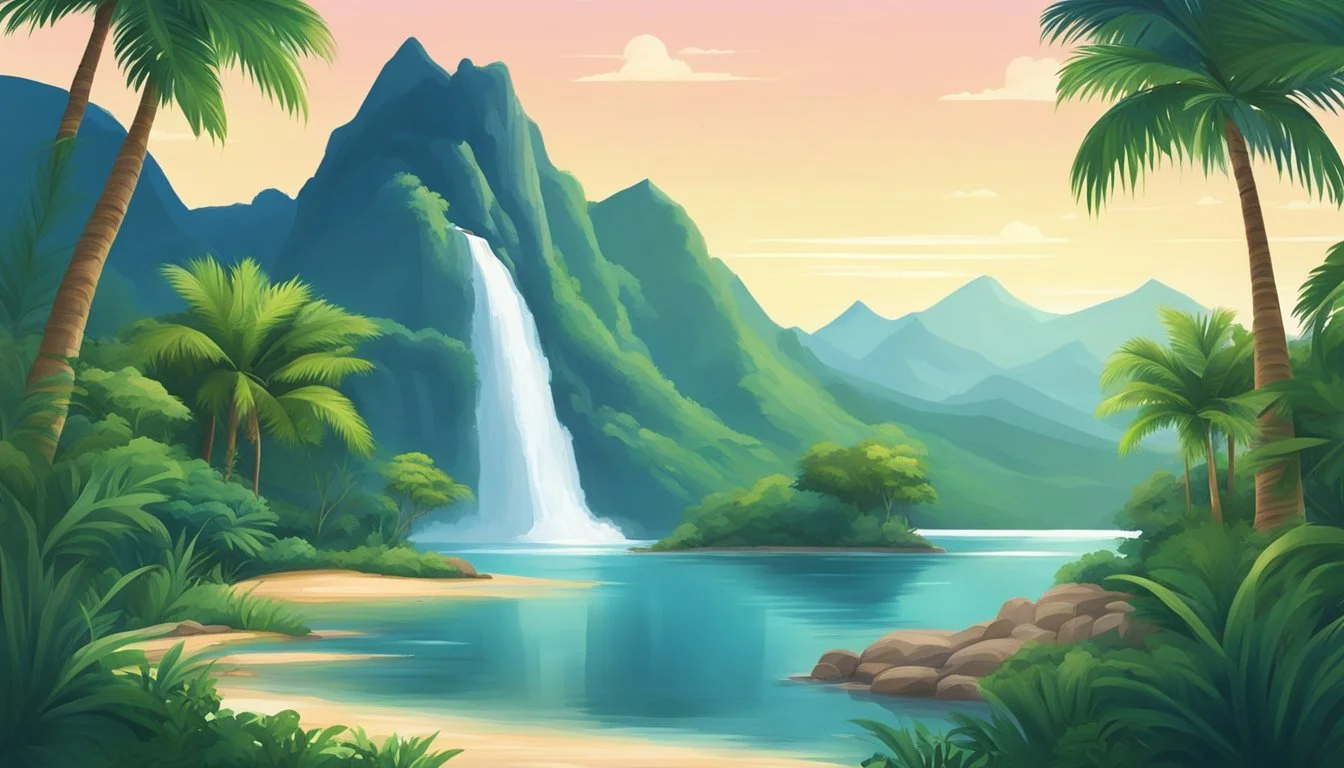Hawaiian Springs vs. Tahoe
Comparing Purity and Taste in Bottled Water
When it comes to bottled water, Hawaiian Springs and Tahoe are two standout brands that offer unique advantages. Hawaiian Springs sources its water from sustainable aquifers in Hawaii, promising a refreshing taste with a hint of sweetness. Tahoe, on the other hand, is known for its purity, drawn from the pristine waters of the Sierra Nevada.
Consumers often find themselves torn between the smooth, almost velvety texture of Hawaiian Springs and the crisp, clean finish of Tahoe. Each brand delivers a distinctly different experience, making the choice largely dependent on personal preference. Some prefer the subtle mineral notes found in Hawaiian Springs, while others lean towards the neutral, almost flavorless profile of Tahoe.
In comparing these two, it's essential to consider not just taste but also the environmental impact and sourcing methods. Hawaiian Springs emphasizes its sustainable practices, making it a choice for those who care about eco-friendly options. Tahoe's reputation for pure, untouched water can be appealing to those seeking the cleanest possible hydration.
Overview of Bottled Water Industry
The bottled water industry has seen substantial growth and transformation over the years, driven by consumer attitudes towards health and convenience. The market boasts a diverse array of brands, each catering to different tastes and preferences.
Evolution of the Bottled Water Market
The bottled water market gained significant traction in the 1970s, with brands like Evian and Perrier leading the way globally. By 2017, the industry's growth accelerated due to increasing health consciousness among consumers.
New entrants, such as Fiji Water and Icelandic Glacial, have emerged, offering unique sources and qualities. Technological advancements and better packaging have made bottled water widely accessible, helping the market expand in both developed and developing regions.
Key Water Brands and Players
The market features a plethora of brands, each claiming unique advantages. Fiji Water, sourced from an aquifer in Fiji, is known for its soft taste. Evian, from the French Alps, is celebrated for its purity. Smartwater and Essentia offer enhanced hydration through electrolytes and ionization, respectively.
Dasani and Aquafina are household names in the United States, accessible and affordable. Brands like Mountain Valley and San Pellegrino cater to premium segments. Companies like Nestle, owning Poland Spring and Zephyrhills, dominate the market with widespread distribution.
Consumer Trends and Preferences
Consumers are increasingly mindful of the source and quality of their bottled water. Naturally alkaline waters like Eternal Water and Waiakea have become popular for their potential health benefits. Sustainable packaging, exemplified by Boxed Water and Path, appeals to eco-conscious buyers.
Flavor-infused waters from Gatorade and Lifewtr cater to those seeking variety. Bottled water sales are driven by convenience, with urban consumers favoring easily portable and ready-to-consume products.
In 2023, the U.S. market alone hit an estimated value of $44.6 billion, reflecting the sector's booming demand. Consumer preferences continue to evolve, pushing brands to innovate and offer new, compelling products.
Health and Hydration
When comparing Hawaiian Springs and Tahoe bottled waters, it's essential to examine their impact on health and hydration. Specific factors include the nutritional content, the hydration benefits they offer, and the role of minerals present in these waters.
Nutritional Comparison of Waters
Hawaiian Springs and Tahoe bottled waters have distinct mineral profiles. Hawaiian Springs water is known for its natural silica content, which may support joint health and skin hydration. Tahoe water prides itself on a balanced mineral composition that includes calcium, magnesium, and potassium.
Table: Key Nutrient Contents
Mineral Hawaiian Springs Tahoe Silica High Moderate Calcium Moderate High Magnesium Moderate High Potassium Moderate High
Overall, both waters offer essential nutrients that support various aspects of health, though their specific contributions vary.
Benefits of Hydration
Hydration plays a crucial role in maintaining optimal health. Both Hawaiian Springs and Tahoe water effectively fulfill the body's hydration needs.
Regular consumption of these waters can lead to improved energy levels, better cognitive function, and enhanced physical performance. Hydration also aids in regulating body temperature, supporting digestion, and promoting detoxification through the kidneys.
Essential electrolytes such as sodium, potassium, and bicarbonate found in these waters contribute to maintaining a proper fluid balance and ensuring that muscle and nerve functions are optimal.
Role of Minerals in Bottled Water
The presence of minerals in Hawaiian Springs and Tahoe water significantly influences their health benefits. Calcium and magnesium are vital for bone health and muscle function. Potassium helps in balancing electrolytes and maintaining proper hydration.
Hawaiian Springs' silica content supports connective tissues and skin health, while chloride assists in digestion by forming a part of stomach acid. TDS (Total Dissolved Solids) levels provide a measure of mineral content, impacting taste and potential health benefits.
In summary, the distinct mineral compositions of Hawaiian Springs and Tahoe waters offer diverse benefits, making them both valuable choices for maintaining health and hydration.
Taste and Purity
Hawaiian Springs and Tahoe bottled waters each offer unique taste profiles and levels of purity. Both are sourced naturally and aim to provide clean, refreshing water.
Factors Influencing Water Taste
Water taste is influenced by minerals, source, and storage. Natural water sources like springs or lakes contribute minerals that give water its unique flavor.
For Hawaiian Springs, the water is sourced from an aquifer deep below volcanic rocks, which imparts a distinct, slightly sweet, and smooth taste. Tahoe water, sourced from alpine regions, has a crisp, clean flavor, often described as refreshing.
Mineral content plays a significant role in the taste. Hawaiian Springs has moderate calcium and magnesium, contributing to its smoothness. Tahoe water is low in minerals, making it taste purer.
Purity and Water Quality Assessments
Water purity is crucial for consumer trust. Hawaiian Springs boasts minimal contaminants due to its filtration through volcanic rock.
Tests show low levels of impurities, ensuring high purity. Tahoe water is similarly pure, sourced from protected alpine environments, which minimizes contaminant exposure.
Hawaiian Springs undergoes regular quality assessments to maintain clean water standards. Tahoe water, protected by its natural environment, also undergoes stringent testing, confirming low contaminant levels. Both brands provide safe and clean water, catering to the health-conscious consumer.
Environmental Impact and Sustainability
The bottled water industry has significant environmental consequences, impacting ecosystems and contributing to plastic pollution. Comparing Hawaiian Springs and Tahoe involves understanding their production processes, packaging choices, and sustainability practices.
Production and Packaging
Production of bottled water involves extracting water from natural sources, which can affect local water tables and ecosystems. Hawaiian Springs sources its water from naturally filtered volcanic rock, potentially having less impact on local water reserves.
Tahoe, conversely, obtains water from the Sierra Nevada, which could strain local resources during droughts. Packaging is another crucial element. Both brands use PET plastic for bottling, which is recyclable but often ends up in landfills. Reducing the carbon footprint during production and choosing more eco-friendly packaging materials are areas needing improvement.
Bottled Water and Plastic Waste
Plastic waste from bottled water is a pressing environmental issue. Bottles discarded improperly contribute to ocean pollution, harming marine life. Hawaiian Springs and Tahoe must address this by enhancing recycling initiatives. Only a small proportion of PET bottles are recycled, primarily due to inadequate recycling infrastructure.
Effective marketing campaigns encouraging consumers to recycle could mitigate this problem. Both brands could also explore alternative materials like biodegradable plastics. The potential for reducing plastic waste lies in consumer education and improved waste management systems.
Sustainable Practices in the Water Industry
The water industry has started to adopt more sustainable practices to address environmental concerns. Hawaiian Springs has invested in renewable energy for its operations and supports local conservation projects. This commitment to sustainability helps foster community goodwill.
Tahoe has initiated efforts to reduce its carbon footprint and engage in watershed protection. Promoting environmentally friendly practices in their marketing and packaging designs can inspire consumers to make better choices. Enhanced transparency about sourcing, production, and waste practices can further entrench their dedication to sustainability.
Both companies aim to balance business goals with the need to protect the environment, reflecting a shift towards more responsible water production.
Source and Production
Hawaiian Springs and Tahoe bottled waters both derive their water from pristine sources and employ meticulous processes to ensure quality. Hawaiian Springs utilizes artesian aquifers while Tahoe relies on mountain spring water.
Natural Sources of Water
Hawaiian Springs sources its water from artesian aquifers in Hawaii. These aquifers are protected and renewable, ensuring a continuous supply of clean water. The water naturally passes through layers of volcanic rock, enriching it with minerals and giving it a slightly alkaline pH.
Tahoe sources its water from mountain springs in the Sierra Nevada. This mountain spring water is collected from protected environments, ensuring it remains pure. The elevation and natural filtration through granite also add to its clean taste and mineral balance.
Water Collection and Bottling Processes
Hawaiian Springs employs a method that bottles water at the source. This practice ensures that the water maintains its natural properties and pH balance. The bottling takes place in high-quality, recyclable containers, highlighting both taste and sustainability. Artisanal collection techniques help preserve its unique mineral profile.
Tahoe uses a technique involving reverse osmosis and advanced filtration. These methods ensure the removal of impurities while preserving essential minerals. The water is also bottled close to the source to maintain freshness. The use of modern, eco-friendly bottling systems underscores their commitment to quality and environmental responsibility.
Consumer Considerations
When selecting between Hawaiian Springs and Tahoe bottled water, several factors play a key role such as pricing, availability, consumer preferences, and brand reputation.
Price and Availability
Price often dictates consumer choices. Hawaiian Springs tends to be on the pricier side due to its sourcing and branding, reflecting its premium nature.
Tahoe bottled water, sourced from Lake Tahoe, offers competitive pricing and is widely available across the USA in popular grocery stores.
Convenience of availability makes it easier for consumers to choose Tahoe water when shopping locally. Both brands establish their presence through multiple channels - from email subscriptions to local stores.
Bottled vs. Tap Water
Consumers often weigh the benefits of bottled water against tap water. Hawaiian Springs and Tahoe aim to offer purity and high alkalinity levels, providing a healthy alternative to tap water.
While some tap water sources are safe, concerns about contamination drive consumers towards trusted bottled options. For the active individual needing hydration on the go, bottled water offers convenience unmatched by relying on water fountains or home tap water.
Choosing bottled over tap also ensures consistency in taste and carbonation levels, appealing to those particular about their drinking water's flow and quality.
Brand Reputation and Reviews
Brand reputation significantly influences consumer choices. Hawaiian Springs is known for its crisp, clean taste, often receiving positive reviews for its neutral flavour profile.
Tahoe water boasts a strong reputation for reliability, given its source from the pristine Lake Tahoe. Consumers appreciate the brand's commitment to quality and environmental consciousness. Scanning reviews, both brands maintain a loyal following, often praised for their premium feel.
Both brands engage through active online presences and direct consumer engagement through email newsletters, fostering trust and loyalty among customers.
Choosing between Hawaiian Springs and Tahoe ultimately boils down to personal preferences in taste, budget, and brand trust.
Conclusion
When evaluating Hawaiian Springs and Tahoe bottled waters, both offer unique features. Hawaiian Springs water is sourced from Mauna Loa on the Big Island of Hawaii. It boasts a notable level of natural filtration through volcanic rock, contributing to its purity.
Tahoe water, on the other hand, hails from Lake Tahoe in California. The pristine environment around Lake Tahoe is a key selling point for this brand.
Hawaiian Springs
Source: Mauna Loa, Hawaii
Filtration: Volcanic rock
Key Feature: Natural purity
Tahoe
Source: Lake Tahoe, California
Filtration: Pristine mountain environment
Key Feature: Environmental sustainability
Taste may also play a role. Consumers often report Hawaiian Springs water to have a smooth, slightly sweet taste, while Tahoe water is known for its crisp, clean flavor.
Any comparison must consider individual preferences. Just as some people prefer the taste of one water over another, others might choose based on environmental impact or purity levels.
More About Hawaiian Springs
Acqua Pana vs Hawaiian Springs: Which Bottled Water is Better?
Aqua Carpatica vs Hawaiian Springs: Which Bottled Water is Better?
Aquafina vs Hawaiian Springs: Which Bottled Water is Better?
Arrowhead vs Hawaiian Springs: Which Bottled Water is Better?
Boxed Water vs Hawaiian Springs: Which Bottled Water is Better?
Castle Rock vs Hawaiian Springs: Which Bottled Water is Better?
Core Hydration vs Hawaiian Springs: Which Bottled Water is Better?
Deer Park vs Hawaiian Springs: Which Bottled Water is Better?
Essentia vs Hawaiian Springs: Which Bottled Water is Better?
Hawaiian Springs vs 1907water: Which Bottled Water is Better?
Hawaiian Springs vs 7-Select: Which Bottled Water is Better?
Hawaiian Springs vs Alkaline88: Which Bottled Water is Better?
Hawaiian Springs vs Antipodes: Which Bottled Water is Better?
Hawaiian Springs vs Big Chill: Which Bottled Water is Better?
Hawaiian Springs vs BodyArmor: Which Bottled Water is Better?
Hawaiian Springs vs Cascade Mountain: Which Bottled Water is Better?
Hawaiian Springs vs CBD Living: Which Bottled Water is Better?
Hawaiian Springs vs Crystal Geyser: Which Bottled Water is Better?
Hawaiian Springs vs Crystal Lake: Which Bottled Water is Better?
Hawaiian Springs vs Essence pH10: Which Bottled Water is Better?
Hawaiian Springs vs Hawaii Volcanic: Which Bottled Water is Better?
Hawaiian Springs vs Kirkland Signature: Which Bottled Water is Better?
Hawaiian Springs vs Liquid Death: Which Bottled Water is Better?
Hawaiian Springs vs Mananalu: Which Bottled Water is Better?
Hawaiian Springs vs Open Water: Which Bottled Water is Better?
Hawaiian Springs vs Proud Source: Which Bottled Water is Better?
Hawaiian Springs vs Pure Life: Which Bottled Water is Better?
Hawaiian Springs vs Purely Sedona: Which Bottled Water is Better?
Hawaiian Springs vs Refreshe: Which Bottled Water is Better?
Hawaiian Springs vs Richard's Rainwater: Which Bottled Water is Better?
Hawaiian Springs vs Simple Truth: Which Bottled Water is Better?
Hawaiian Springs vs Solan de Cabras: Which Bottled Water is Better?
Hawaiian Springs vs Talking Rain AQA: Which Bottled Water is Better?
Hawaiian Springs vs The Well: Which Bottled Water is Better?
Hawaiian Springs vs Tru Alka: Which Bottled Water is Better?
Hawaiian Springs vs Weird Water: Which Bottled Water is Better?
Hawaiian Springs vs Whole Foods 365: Which Bottled Water is Better?
Hawaiian Springs vs Whole Foods Italian Still Mineral water: Which Bottled Water is Better?
Ice Mountain vs Hawaiian Springs: Which Bottled Water is Better?
Icelandic Glacial vs Hawaiian Springs: Which Bottled Water is Better?
Just Water vs Hawaiian Springs: Which Bottled Water is Better?
Mountain Valley Spring Water vs Hawaiian Springs: Which Bottled Water is Better?
Nestle Pure Life vs Hawaiian Springs: Which Bottled Water is Better?
Poland Spring vs Hawaiian Springs: Which Bottled Water is Better?
San Pellegrino vs Hawaiian Springs: Which Bottled Water is Better?
Smartwater vs Hawaiian Springs: Which Bottled Water is Better?
Topo Chico vs Hawaiian Springs: Which Bottled Water is Better?
Zephyrhills vs Hawaiian Springs: Which Bottled Water is Better?







